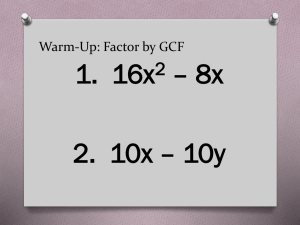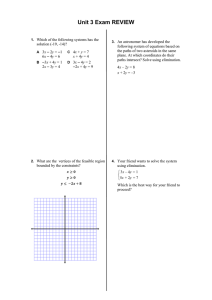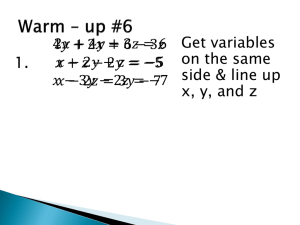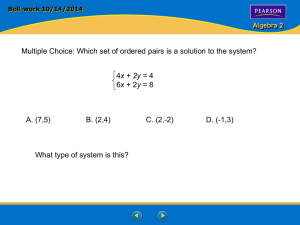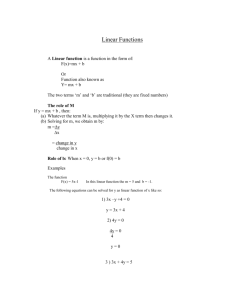Functions of Two Variables Definition of a function of two variables
advertisement
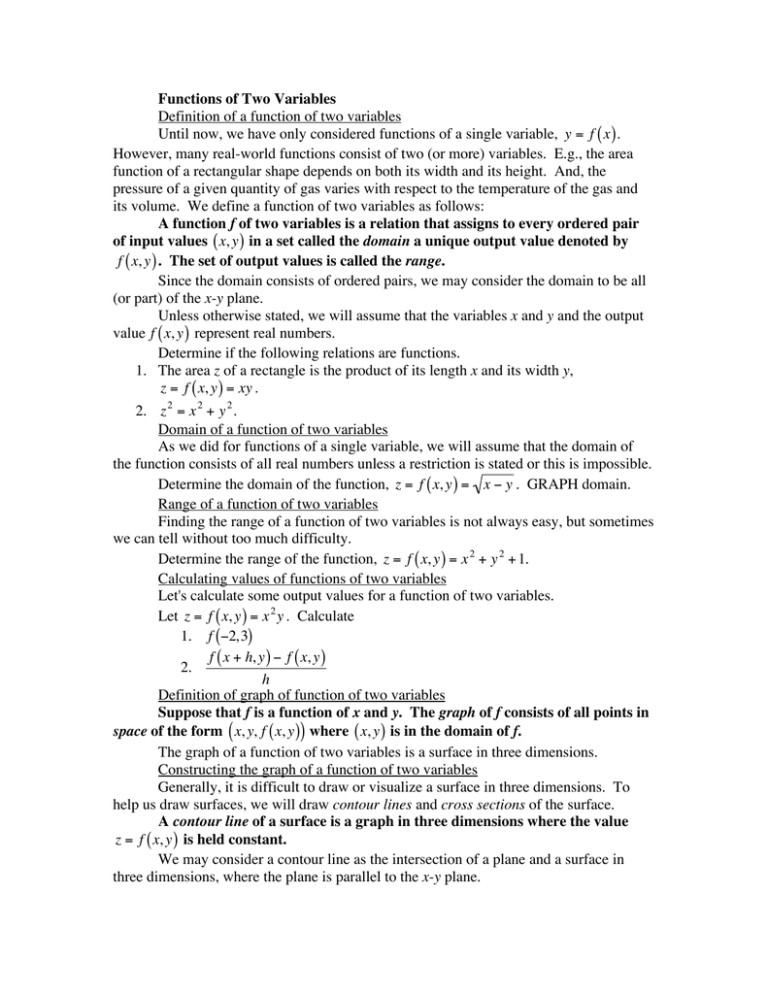
! ! ! Functions of Two Variables Definition of a function of two variables Until now, we have only considered functions of a single variable, y = f ( x ) . However, many real-world functions consist of two (or more) variables. E.g., the area function of a rectangular shape depends on both its width and its height. And, the pressure of a given quantity of gas varies with respect to the temperature of the gas and its volume. We define a function of two variables as follows: ! A function f of two variables is a relation that assigns to every ordered pair of input values ( x, y ) in a set called the domain a unique output value denoted by f ( x, y ) . The set of output values is called the range. Since the domain consists of ordered pairs, we may consider the domain to be all (or part) of the x-y plane. ! Unless otherwise stated, we will assume that the variables x and y and the output value f ( x, y ) represent real numbers. Determine if the following relations are functions. 1. The area z of a rectangle is the product of its length x and its width y, z = f ( x, y ) = xy . 2. z 2 = x 2 + y 2 . Domain of a function of two variables As we did for functions of a single variable, we will assume that the domain of ! the function consists of all real numbers unless a restriction is stated or this is impossible. ! Determine the domain of the function, z = f ( x, y ) = x " y . GRAPH domain. Range of a function of two variables Finding the range of a function of two variables is not always easy, but sometimes we can tell without too much difficulty. ! Determine the range of the function, z = f ( x, y ) = x 2 + y 2 + 1. Calculating values of functions of two variables Let's calculate some output values for a function of two variables. Let z = f ( x, y ) = x 2 y . Calculate ! 1. f ("2,3) f ( x + h, y ) " f ( x, y ) 2. h ! Definition of graph of function of two variables ! Suppose that f is a function of x and y. The graph of f consists of all points in space of the form ( x, y, f ( x, y )) where ( x, y ) is in the domain of f. ! The graph of a function of two variables is a surface in three dimensions. Constructing the graph of a function of two variables Generally, it is difficult to draw or visualize a surface in three dimensions. To ! surfaces, we will!draw contour lines and cross sections of the surface. help us draw A contour line of a surface is a graph in three dimensions where the value z = f ( x, y ) is held constant. We may consider a contour line as the intersection of a plane and a surface in three dimensions, where the plane is parallel to the x-y plane. ! ! ! ! ! ! Consider a situation where a family's weekly income consists of the sum of the husband's and wife's salaries. If the husband earns $5 per hour and works x hour per week, and the wife earns $10 per hour and works y hours per week, then the family's weekly income is z = f ( x, y ) = 5x + 10y , where the domain is x " 0 and y " 0 . Our goal is to graph this function in three dimensions. We begin by drawing some contour lines. Let z = 200 , then the family's weekly income is $200, and 5x + 10y = 200 . This is a linear equation. So we can conclude that all ( x, y ) that satisfy 5x + 10y = 200 are ! ! contained on the line segment connecting the points (0,20) and ( 40,0) . Remember that for ! these points z = 200 on the contour line. This graph is !a line segment in three dimensions. Let's plot some more contour lines. ! ! Let z = 300 , then the family's weekly income is $300, and 5x + 10y = 300 . All ! on the!line segment connecting the points that satisfy 5x + 10y = 300 are contained ( x, y ) ! (0,30) and (60,0) . Label the contour line z = 300 . Let z = 400 , then the family's weekly income is $400, and 5x + 10y = 400 . All ! ! ( x, y ) that ! satisfy 5x + 10y = 400 are contained on the line segment connecting the points and (80,0) . Label the contour (0,40 ! line z = 400 . ! ) By placing all of these graphs together on the same ! ! x-y axes and clearly labeling the value of z with each graph, we begin to understand the graph (surface) of our function ! in three dimensions. ! ! Another aid to drawing graphs of functions of two variables is to sketch the cross sections of the surface. A cross section of a surface is a graph in three dimensions where the value of either the x or y variables is held constant. Consider our earlier problem where z = f ( x, y ) = 5x + 10y . Draw the cross section where x = 0 . Note the graph of x = 0 is, in fact, the yz plane. The cross section of z = f ( x, y ) = 5x + 10y where x = 0 is the line z = f ( x, y ) = 10y in the yz plane. ! Draw the cross section ! where y = 0 . Note the!graph of y = 0 is the xz plane. The = 0 is the line z = f ( x, y ) = 5x in the xz cross section of z = f ( x, y ) = 5x + 10y where y ! ! plane. Since the domain of z consisted of all x " 0 and y " 0 , we may consider these two ! ! cross sections as limiting lines of our surface. The graph (surface) of z consists of all ! ! first octant of the xyz space. points! on contour lines between these two lines in the Rate of change in the x and y directions !of change of a function of two variables. However, We can also consider the rate since we have two variables, we can consider two rates of change: a rate of change in the x direction and a rate of change in the y direction. Consider our earlier problem where z = f ( x, y ) = 5x + 10y . What is the rate of change of z in the x direction? For each increase of one unit in x, the value of z increases by 5. Therefore, the rate of change in the x direction is "z 10 "z 5 = = 10 . lim = = 5 . And, the rate of!change in the y direction is lim "y #0 "y "x #0 "x 1 1 !

